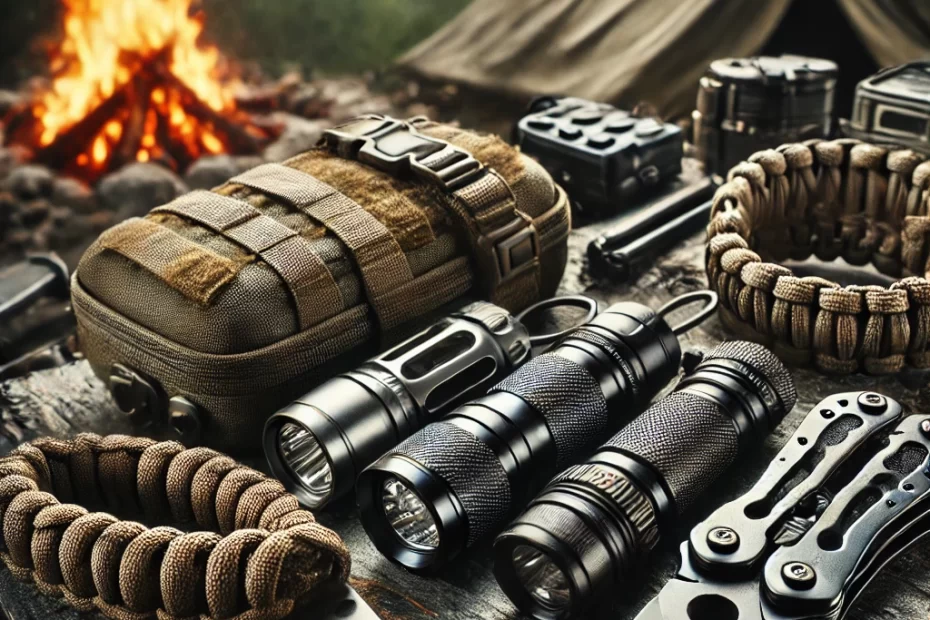Introduction:
When disaster strikes, having the right survival gear can mean the difference between life and death. Whether you’re preparing for natural disasters, outdoor adventures, or emergency scenarios, these top 10 survival essentials are a must-have in 2025.
1. Multi-Tool (Survival Knife & Gear)
A high-quality multi-tool is an absolute necessity for survival. It should include:
✅ A sturdy, full-metal construction that won’t break under pressure.
✅ Pliers for gripping and handling small objects.
✅ A sharp, durable knife blade for cutting and general use.
✅ A saw to handle small branches and wood processing.
✅ A screwdriver (both flathead and Phillips) for repairs.
💡 Pro Tip: Avoid cheap multi-tools with plastic parts, as they tend to break easily under pressure. A full-tang design (where the metal extends through the handle) is much more reliable.
🔹 Pros: Compact, multi-functional, saves space in your gear.
🔹 Cons: Some cheaper models can break under heavy use.
2. Fire Starter (Waterproof & Windproof)
Fire is essential for warmth, cooking, and safety. A reliable fire starter should:
✅ Be waterproof and windproof to function in any weather.
✅ Have a long lifespan (ferrocerium rods last thousands of strikes).
✅ Be compact and easy to use, even in an emergency.
💡 Pro Tip: Always carry multiple fire-starting methods—a ferro rod, waterproof matches, and a lighter—so you have backup options if one fails.
🔹 Pros: Reliable in all conditions, lightweight.
🔹 Cons: Takes practice to master compared to a lighter.
3. Emergency Water Filtration System
Clean drinking water is vital for survival. A good filtration system should:
✅ Remove bacteria, parasites, and microplastics from contaminated water.
✅ Be lightweight and easy to carry for on-the-go use.
✅ Have a long filter life, so it doesn’t need frequent replacements.
💡 Pro Tip: Learn how to make a DIY water filter using sand, charcoal, and gravel in case you ever need a backup purification method.
🔹 Pros: Ensures safe drinking water anywhere.
🔹 Cons: Some models have slower filtration speeds.
4. Tactical Flashlight & Solar Charger
A dependable flashlight with a solar charger is crucial for low-light conditions. Look for:
✅ High lumens (at least 1000+ lumens) for maximum brightness.
✅ USB rechargeable and solar-powered backup for long-term reliability.
✅ Durability—shockproof and waterproof features for rugged use.
💡 Pro Tip: A flashlight with an SOS strobe mode can be a lifesaver for signaling in emergencies.
🔹 Pros: Can be used for self-defense, lasts a long time.
🔹 Cons: Cheap models may not hold a charge for long.
5. First Aid Kit (Comprehensive & Compact)
A well-stocked first aid kit should include:
✅ Bandages, gauze, and antiseptics for wound treatment.
✅ Pain relievers and allergy medication for common medical issues.
✅ A tourniquet and medical tape for more serious injuries.
💡 Pro Tip: Take a basic first-aid course so you know how to properly use everything in your kit.
🔹 Pros: Can save lives in emergencies.
🔹 Cons: Needs regular restocking to stay effective.
6. Emergency Food Rations (Long Shelf Life)
Food storage is a key part of survival planning. Good emergency food should:
✅ Have a shelf life of 5-25 years for long-term preparedness.
✅ Provide high-calorie nutrition to sustain energy.
✅ Be easy to prepare, even without cooking.
💡 Pro Tip: Rotate your stockpile regularly to keep your food fresh and avoid waste.
🔹 Pros: Provides peace of mind for food shortages.
🔹 Cons: Some MREs have high sodium content.
7. Survival Tent or Emergency Shelter
A reliable shelter keeps you warm and protected from the elements. The best options:
✅ Lightweight and compact for easy transport.
✅ Waterproof and windproof to withstand harsh conditions.
✅ Reflective interior to retain body heat.
💡 Pro Tip: Practice setting up your shelter before an emergency happens so you can do it quickly when needed.
🔹 Pros: Provides critical protection against extreme weather.
🔹 Cons: Some emergency shelters tear easily if not handled properly.
8. Paracord Bracelet & Rope Kit
Paracord is one of the most versatile survival tools. It can be used for:
✅ Shelter building, securing gear, and making traps.
✅ Emergency situations like stopping bleeding (tourniquet use).
✅ Fishing and tool-making in extreme survival situations.
💡 Pro Tip: Learn five essential paracord knots to maximize its use in survival situations.
🔹 Pros: Strong, lightweight, and multi-functional.
🔹 Cons: Takes up space if you carry too much.
9. Personal Defense & Self-Protection Tools
Personal safety in survival situations is a priority. The best tools include:
✅ Pepper spray or tactical batons for self-defense.
✅ A tactical pen that doubles as a weapon and glass breaker.
✅ A concealed survival knife for protection and utility.
💡 Pro Tip: Always check local laws regarding carrying self-defense tools in your area.
🔹 Pros: Provides personal security in unpredictable situations.
🔹 Cons: Legal restrictions vary by location.
10. Emergency Radio (Hand-Crank & Solar Powered)
Staying informed during an emergency is crucial. A good survival radio should:
✅ Include NOAA weather alerts for disaster updates.
✅ Have hand-crank, battery, and solar power options for reliability.
✅ Be compact and lightweight for easy carrying.
💡 Pro Tip: Keep an extra set of rechargeable batteries in case of extended power outages.
🔹 Pros: Provides life-saving information when power grids are down.
🔹 Cons: Some models have weak signals in remote areas.
Final Thoughts:
Preparedness starts with the right gear. Whether you’re an experienced survivalist or just getting started, these top 10 survival essentials should be in every emergency kit. Stay ready, stay safe.
